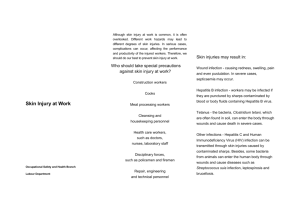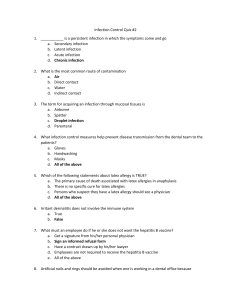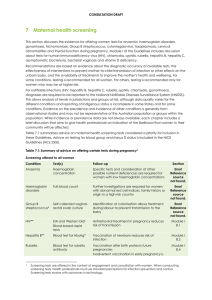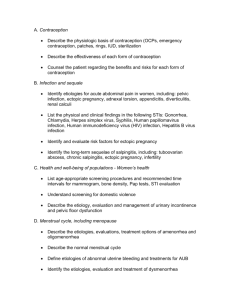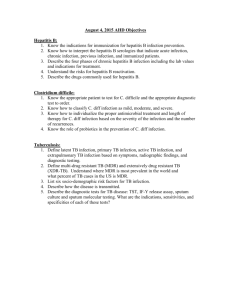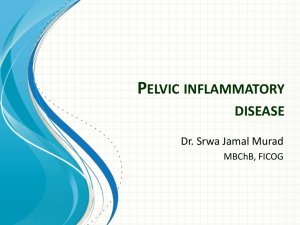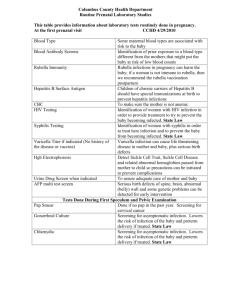2014 Written Specialties Feedback
advertisement
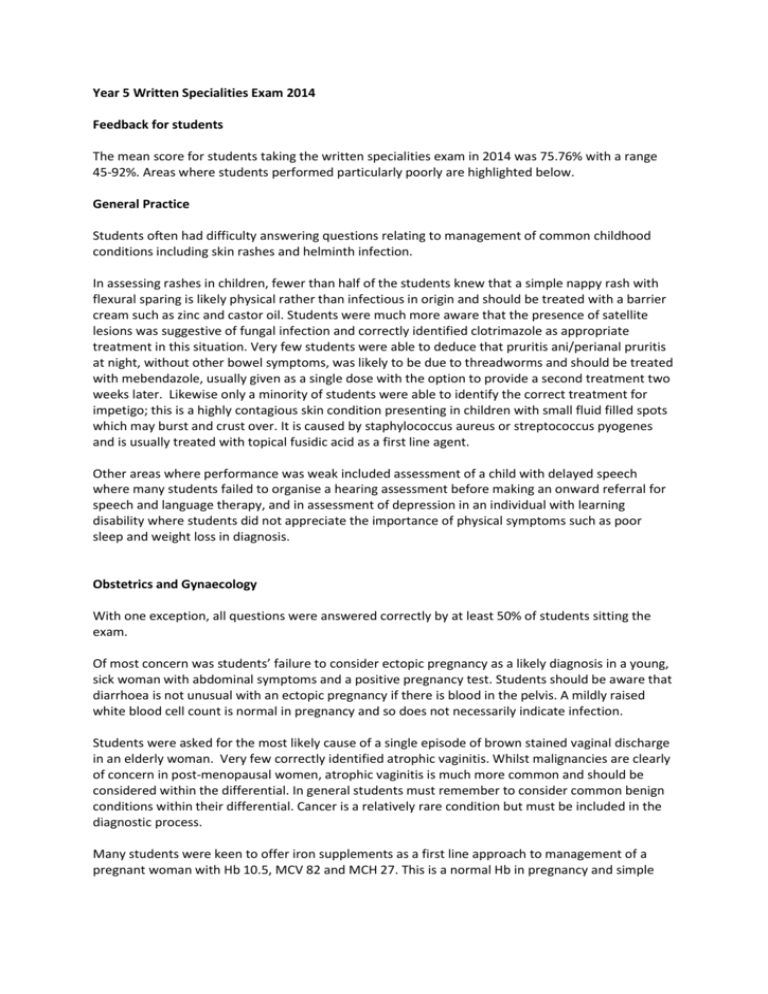
Year 5 Written Specialities Exam 2014 Feedback for students The mean score for students taking the written specialities exam in 2014 was 75.76% with a range 45-92%. Areas where students performed particularly poorly are highlighted below. General Practice Students often had difficulty answering questions relating to management of common childhood conditions including skin rashes and helminth infection. In assessing rashes in children, fewer than half of the students knew that a simple nappy rash with flexural sparing is likely physical rather than infectious in origin and should be treated with a barrier cream such as zinc and castor oil. Students were much more aware that the presence of satellite lesions was suggestive of fungal infection and correctly identified clotrimazole as appropriate treatment in this situation. Very few students were able to deduce that pruritis ani/perianal pruritis at night, without other bowel symptoms, was likely to be due to threadworms and should be treated with mebendazole, usually given as a single dose with the option to provide a second treatment two weeks later. Likewise only a minority of students were able to identify the correct treatment for impetigo; this is a highly contagious skin condition presenting in children with small fluid filled spots which may burst and crust over. It is caused by staphylococcus aureus or streptococcus pyogenes and is usually treated with topical fusidic acid as a first line agent. Other areas where performance was weak included assessment of a child with delayed speech where many students failed to organise a hearing assessment before making an onward referral for speech and language therapy, and in assessment of depression in an individual with learning disability where students did not appreciate the importance of physical symptoms such as poor sleep and weight loss in diagnosis. Obstetrics and Gynaecology With one exception, all questions were answered correctly by at least 50% of students sitting the exam. Of most concern was students’ failure to consider ectopic pregnancy as a likely diagnosis in a young, sick woman with abdominal symptoms and a positive pregnancy test. Students should be aware that diarrhoea is not unusual with an ectopic pregnancy if there is blood in the pelvis. A mildly raised white blood cell count is normal in pregnancy and so does not necessarily indicate infection. Students were asked for the most likely cause of a single episode of brown stained vaginal discharge in an elderly woman. Very few correctly identified atrophic vaginitis. Whilst malignancies are clearly of concern in post-menopausal women, atrophic vaginitis is much more common and should be considered within the differential. In general students must remember to consider common benign conditions within their differential. Cancer is a relatively rare condition but must be included in the diagnostic process. Many students were keen to offer iron supplements as a first line approach to management of a pregnant woman with Hb 10.5, MCV 82 and MCH 27. This is a normal Hb in pregnancy and simple advice about including dark green leafy vegetables, pulses, beans, nuts, seeds and brown rice in the diet is the most appropriate response. Students were confused about screening tests for virus infection in pregnancy. Most serological tests looking for IgG antibodies identify prior infection (eg hepatitis B core antibody) or prior vaccination (eg hepatitis surface antibody). The presence of IgM antibodies usually identifies active or recent infection. Tests for active infection may involve testing for the presence of the virus by identifying viral antigens (eg hepatitis B surface antigen) or DNA (hepatitis B DNA). The latter is not usually requested routinely as it is an expensive test. These screening results are documented in every pregnant woman’s handheld notes. Students failed to recognize features of uterine rupture. This may be preceded by hypercontractility of the uterus. The rupture results in fetal compromise with reduced fetal movements and bradycardia. Rupture into the bladder may result in haematuria. Suprapubic pain is a classic symptom. Psychiatry Students were not sufficiently able to distinguish between clinical presentations of different types of dementia. They should be aware of features of vascular dementia, frontotemporal dementia and Alzheimer’s disease. Only a minority of students made a correct diagnosis of Alzheimer’s disease based on a history of poor memory, difficulty in word finding and difficulty in planning. Students showed very poor judgement when asked about management of an agitated patient and failed to think through the scenario sensibly. If called to a ward in this situation a junior doctor would initially assess the patient, in a safe environment with another person present, before telephoning a consultant or prescribing a tranquilliser. Likewise students showed poor judgement in management of an unconscious patient without capacity to consent to surgery. The involvement of close family members in decision-making is crucial in such cases. Many students failed to appreciate the importance of patient education when prescribing medication for individuals with a chronic disease. This is important not only in psychiatry but in very many other chronic conditions (diabetes, rheumatoid arthritis, inflammatory bowel disease etc) where patients need to take long term treatments that may be unpleasant to administer (eg injected) or associated with side effects or the need for regular monitoring. Students did not always understand the role of the health visitor in advising parents on management of minor behavioural problems in young children. Support and advice from an experienced health professional is often all that is needed to help parents deal with sleep or eating difficulties in their children. Paediatrics Students should understand more fully the impact of brain injury/disorders on children; these may be associated with neurological defects but are frequently also associated with psychiatric comorbidity. Students should be able to distinguish between different causes of headaches in children and tailor their investigation and management plan accordingly. Very few students identified early use of paracetamol as the best first line treatment for mild migraine. At the other extreme, when presented with a febrile child with neck stiffness and a history of convulsions, very few students identified the need for a CT scan with many students opting to do a lumbar puncture as a first line investigation. Where there is concern about an intracranial abnormality a CT scan needs to be done prior to a lumbar puncture to reduce the risks of complications associated with this procedure. Overall students did not perform well in questions relating to infection. Fewer than half were able to identify herpes simplex as a likely cause of blistering lesions, malaise and fevers as a complication of childhood eczema. A smaller minority still were able to identify parvovirus as a cause of a febrile illness with rash and arthralgias associated with subsequent still birth and hydrops foetalis.


